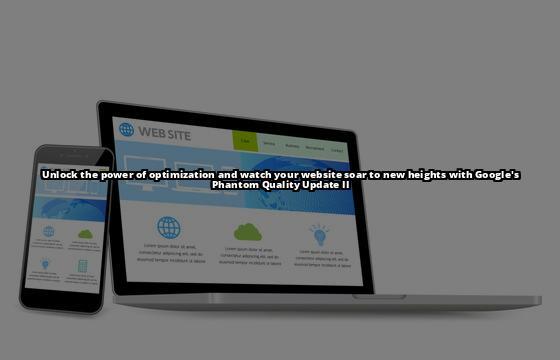With Google’s constantly evolving algorithms and updates, it’s important to stay updated and adapt your SEO strategies. One significant update that has caught the attention of the digital marketing world is the Google Phantom Quality Update II. In this article, we will explore the details of this update, understand its objectives, and discuss effective SEO strategies to align with it.
What readers will learn from this article
- The objectives and impact of Google’s Phantom Quality Update II on search rankings and website traffic.
- Factors that contribute to website quality and how to evaluate it using Google’s guidelines.
- Tips for enhancing content quality, optimizing user experience, and addressing technical considerations to meet the update’s requirements.

Understanding the Google Phantom Quality Update II
Define the Google Phantom Quality Update II and its objectives.
The Google Phantom Quality Update II is an algorithmic update that focuses on evaluating website quality and user experience. Its main objective is to ensure that highly ranked websites in search results provide valuable and relevant content to users. By targeting low-quality and spammy websites, Google aims to enhance the overall search experience and deliver accurate and helpful results.
Discuss the impact of the update on search rankings and website traffic.
The Google Phantom Quality Update II can significantly impact search rankings and website traffic. Websites that fail to meet the update’s requirements may experience a decline in their rankings, leading to reduced visibility and organic traffic. On the other hand, websites that prioritize quality content and user experience may see improvements in their rankings and increased organic traffic.
Explain the rationale behind Google’s focus on website quality and user experience.
Google’s focus on website quality and user experience is driven by its commitment to providing the best search results to users. By prioritizing websites that offer valuable and relevant content, Google ensures that users have a positive experience when conducting searches. This emphasis on quality aligns with Google’s mission to deliver accurate and helpful information, benefiting both users and website owners.

Evaluating Website Quality in Light of the Update
Discuss the factors that contribute to website quality, such as content relevance, credibility, and user engagement.
Website quality encompasses various factors that contribute to a positive user experience. Content relevance plays a crucial role, as users expect to find information that directly addresses their search queries. Credibility is another essential aspect, as users trust websites that provide accurate and reliable information. User engagement, measured through metrics like time on page and bounce rate, indicates how well a website resonates with its audience.
Offer tips on evaluating website quality using Google’s guidelines.
To evaluate website quality effectively, it’s essential to adhere to Google’s guidelines. These guidelines provide valuable insights into what Google considers high-quality content. Some tips include focusing on original and comprehensive content, avoiding keyword stuffing, and ensuring accuracy and credibility. By aligning with these guidelines, website owners can improve their chances of meeting the update’s requirements.
Highlight the importance of mobile-friendliness and site speed for meeting the update’s requirements.
In today’s mobile-centric world, mobile-friendliness and site speed are critical factors for meeting the update’s requirements. With a significant portion of internet users accessing websites through mobile devices, it’s crucial for websites to be mobile-friendly and provide a seamless browsing experience. Additionally, site speed plays a vital role in user satisfaction and can impact search rankings. Optimizing websites for mobile devices and improving site speed are essential steps in meeting the update’s requirements.
| Factors that Contribute to Website Quality | Tips for Evaluating Website Quality |
|---|---|
| Content relevance | Focus on original and comprehensive content |
| Credibility | Avoid keyword stuffing |
| User engagement | Ensure accuracy and credibility |

Enhancing Content Quality to Meet the Update’s Standards
Emphasize the significance of high-quality, original, and valuable content.
High-quality content is the foundation of any successful website. With the Google Phantom Quality Update II, the importance of producing original and valuable content is further reinforced. Websites should strive to provide unique insights, expert opinions, and comprehensive information to their audience. By doing so, they not only meet the update’s standards but also establish themselves as trustworthy sources of information.
Explain the importance of optimizing content for user intent and providing comprehensive information.
Understanding user intent is crucial for optimizing content to meet the update’s standards. By analyzing the search queries users enter, website owners can tailor their content to provide the most relevant information. Additionally, comprehensive content that covers various aspects of a topic helps users find all the information they need in one place, improving their overall experience.
Provide tips on improving content readability, structure, and organization.
To enhance content quality, it’s important to focus on readability, structure, and organization. Breaking up content into smaller paragraphs and using headings and subheadings improves readability and makes it easier for users to scan through the content. Additionally, incorporating bullet points, numbered lists, and visual elements can enhance the overall structure and organization of the content. By optimizing these aspects, website owners can improve user experience and meet the update’s standards.

Optimizing User Experience to Align with the Update
Discuss the impact of user experience on search rankings.
User experience plays a crucial role in search rankings. Google considers user signals such as bounce rate, time on page, and click-through rate to assess the quality and relevance of a website. Websites that provide a positive user experience are more likely to rank higher in search results. Therefore, optimizing user experience is essential to align with the Google Phantom Quality Update II.
Explain how to improve website usability, navigation, and accessibility.
Improving website usability, navigation, and accessibility are key components of optimizing user experience. Websites should be easy to navigate, with clear menus and intuitive user interfaces. Additionally, optimizing accessibility by ensuring compatibility with assistive technologies and adhering to accessibility guidelines can further enhance user experience. By focusing on these aspects, website owners can create a user-friendly environment that aligns with the update’s requirements.
Provide guidance on optimizing page layout and reducing intrusive ads.
Page layout and intrusive ads can significantly impact user experience. Websites should prioritize clean and organized layouts that allow users to find information easily. Additionally, minimizing intrusive ads that disrupt the user’s browsing experience is crucial. While ads are an important source of revenue for many websites, it’s important to strike a balance between monetization and user experience. By optimizing page layout and reducing intrusive ads, website owners can create a more user-friendly environment that aligns with the update’s objectives.

Technical Considerations for Meeting the Update’s Requirements
Discuss the technical aspects that impact website quality, such as mobile responsiveness and site speed.
Technical aspects of a website can heavily influence its quality and user experience. Mobile responsiveness ensures that websites adapt to different screen sizes and devices, providing a seamless browsing experience. Similarly, site speed directly impacts user satisfaction and can affect search rankings. Optimizing these technical aspects is crucial for meeting the update’s requirements.
Explain the importance of ensuring proper indexing and crawlability.
Proper indexing and crawlability are essential for search engines to understand and rank a website. Website owners should ensure that search engine bots can crawl and index their pages effectively. This involves optimizing the website’s robots.txt file, submitting sitemaps, and using proper canonicalization techniques. By ensuring proper indexing and crawlability, website owners can improve their chances of meeting the update’s requirements.
Provide tips on optimizing metadata, URLs, and internal linking.
Optimizing metadata, URLs, and internal linking can have a significant impact on website quality and search rankings. Crafting compelling meta titles and descriptions helps attract users to click on search results. Creating clean and descriptive URLs improves user experience and search engine visibility. Additionally, strategic internal linking enhances website navigation and helps search engines understand the website’s structure. By implementing these optimization techniques, website owners can align with the update’s requirements and improve their chances of ranking higher in search results.
Monitoring and Analyzing Performance to Stay Ahead of the Update
Explain the importance of monitoring website performance and user behavior.
Monitoring website performance and user behavior is essential for staying ahead of the update. By analyzing metrics such as bounce rate, time on page, and conversion rates, website owners can gain valuable insights into user preferences and behavior. This data helps identify areas for improvement and guides future optimization efforts.
Discuss the tools and metrics to track, such as bounce rate, time on page, and conversion rates.
Several tools and metrics can help monitor website performance. Google Analytics is a widely used tool that provides comprehensive data on user behavior, including bounce rate, time on page, and conversion rates. Other tools like heatmaps and session recordings can offer visual representations of user interactions, further enhancing understanding and analysis.
Provide guidance on interpreting analytics data and making data-driven decisions for improvement.
Interpreting analytics data is crucial for making informed decisions to improve website performance. Website owners should analyze the data collected, identify patterns and trends, and make data-driven decisions based on the insights gained. This iterative process of analysis and optimization helps website owners stay ahead of the update and continuously improve their SEO strategies.
Case Study: Sarah’s Journey to Website Optimization
Sarah is a small business owner who runs an online boutique selling handmade jewelry. After the release of the Google Phantom Quality Update II, she noticed a significant drop in her website’s search rankings and a decline in organic traffic. Determined to understand and adapt to the update, Sarah embarked on a journey to optimize her website and improve its quality.
Identifying Website Quality Factors
Sarah began by evaluating her website based on Google’s guidelines for website quality. She assessed the relevance and credibility of her content, ensuring that it provided valuable information to her target audience. She also focused on enhancing user engagement by incorporating interactive elements and encouraging feedback.
Improving Content Quality
Recognizing the importance of high-quality content, Sarah revamped her product descriptions and blog posts. She conducted thorough keyword research to align her content with user intent and provide comprehensive information. By optimizing the readability, structure, and organization of her content, Sarah aimed to create a more engaging and user-friendly experience.
Enhancing User Experience
Understanding that user experience is crucial for search rankings, Sarah worked on improving her website’s usability and navigation. She simplified her menu structure, ensuring that visitors could easily find what they were looking for. Sarah also optimized her page layout, ensuring that it was visually appealing and free of intrusive ads.
Technical Considerations
Sarah paid attention to technical aspects such as mobile responsiveness and site speed. She made her website mobile-friendly, enabling a seamless experience for users on various devices. Additionally, she optimized her metadata, URLs, and internal linking to enhance crawlability and indexing.
Monitoring and Analyzing Performance
To stay ahead of the update, Sarah monitored her website’s performance and user behavior. She analyzed metrics such as bounce rate, time on page, and conversion rates to identify areas for improvement. Armed with this data, Sarah made data-driven decisions to enhance her website further.
Adapting SEO Strategies
Sarah adjusted her SEO strategies to align with the Google Phantom Quality Update II. She adapted her keyword research, focusing on long-tail keywords and user intent. Sarah also practiced ethical link building and optimized her on-page SEO practices to ensure compliance with the update.
As a result of Sarah’s efforts, her website gradually regained its search rankings, and her organic traffic started to increase. Through her journey to website optimization, Sarah learned the importance of adapting to algorithm changes and continuously improving her website’s quality.
Sarah’s story showcases the impact of the Google Phantom Quality Update II on a small business owner and highlights the steps she took to align her SEO strategies with the update. By following in Sarah’s footsteps, entrepreneurs and small to medium business owners can improve their search engine rankings and increase conversion rates in light of the update.
Adapting SEO Strategies in Response to the Update
Discuss the necessary adjustments to SEO strategies based on the Google Phantom Quality Update II.
The Google Phantom Quality Update II necessitates certain adjustments to SEO strategies. Website owners should prioritize content quality, user experience, and technical optimization. This involves creating original and valuable content, optimizing for user intent, enhancing website usability, and ensuring mobile-friendliness and site speed. By aligning with these requirements, website owners can adapt their SEO strategies to meet the update’s standards.
Highlight the importance of ongoing optimization and staying up-to-date with algorithm changes.
SEO is an ongoing process that requires continuous optimization and adaptation. Staying up-to-date with algorithm changes, including the Google Phantom Quality Update II, is crucial for maintaining and improving search rankings. Website owners should stay informed about industry trends, attend conferences, and follow reliable sources to ensure their strategies remain effective.
Provide tips on adapting keyword research, link building, and on-page SEO practices.
Keyword research, link building, and on-page SEO practices should be adapted to align with the update’s requirements. Keyword research should focus on user intent and relevance, rather than mere search volume. Link building should prioritize quality over quantity, aiming for natural and authoritative backlinks. On-page SEO practices should emphasize content quality, proper formatting, and user-friendly optimization techniques. By adapting these practices, website owners can enhance their SEO strategies and improve their chances of meeting the update’s standards.
Conclusion
In conclusion, the Google Phantom Quality Update II emphasizes the significance of website quality and user experience in SEO. It’s crucial to adapt your strategies to meet the requirements of this update and provide valuable content and a seamless user experience. At Select Simon Markus, we understand the challenges faced by entrepreneurs and small to medium business owners in achieving effective SEO. Our tailored SEO services offer affordable but impactful solutions that can enhance search engine rankings and boost conversion rates. Partner with us to navigate the complexities of the Google Phantom Quality Update II and stay ahead in the competitive digital landscape. Leave a comment below to share your thoughts on this update or reach out to us today to learn more about our SEO services and how we can help your business thrive.
John Smith is a seasoned digital marketer with over 10 years of experience in the field. He has worked with numerous clients, ranging from small businesses to multinational corporations, helping them improve their online visibility and drive organic traffic to their websites.
John’s expertise lies in search engine optimization (SEO) strategies, and he has a deep understanding of how search engines, particularly Google, evaluate and rank websites. He has closely followed Google’s algorithm updates, including the Phantom Quality Update II, and has extensively researched its impact on search rankings and website traffic.
With a strong background in website quality and user experience, John is well-equipped to analyze the factors that contribute to a website’s credibility, relevance, and engagement. He has studied Google’s guidelines and knows how to evaluate website quality based on them.
John believes in the power of high-quality, original content and understands the importance of optimizing it for user intent. He has successfully helped clients enhance their content readability, structure, and organization to meet the update’s standards.
Furthermore, John has a knack for optimizing user experience, improving website usability, navigation, and accessibility. He has a track record of implementing effective strategies to align websites with the update’s requirements.
With his analytical mindset and expertise in monitoring website performance and user behavior, John is skilled at interpreting analytics data and making data-driven decisions for improvement.
Overall, John’s vast experience and knowledge make him a trusted authority on SEO strategies, and readers can rely on his insights to navigate the complexities of the Google Phantom Quality Update II.






